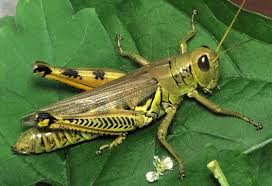By SAUNDRA McBREARTY
Before my 2nd grader hopped off to her first day of school this week, we noticed a big grasshopper basking in our flowerbed. Striped in dramatic green and yellow chevron patterns, it stared at us with its compound eyes as we approached. Just before my daughter could scoop it up, the sneaky grasshopper leaped one giant meter-long jump! We squealed in delight as we searched to find it camouflaged against another green leaf. Enchanted by this game of tag, I started to wonder about this remarkable insect.
 There are around 11,000 known species of grasshoppers found around the world, often living in grassy fields, meadows and forests. The species we played with on this morning is the differential grasshopper (Melanoplus differentialis), which is well adapted to urban living and can make empty lots, gardens and overgrown areas home.
There are around 11,000 known species of grasshoppers found around the world, often living in grassy fields, meadows and forests. The species we played with on this morning is the differential grasshopper (Melanoplus differentialis), which is well adapted to urban living and can make empty lots, gardens and overgrown areas home.
Grasshoppers see the world differently from people. They are equipped with five eyes in total! Two sizable compound eyes sit on the sides of their heads and three simple eyes are directly between them. Compound eyes consist of thousands of mini eye divisions, each equipped with lenses. Each lens takes in small portions of light from the full image that the grasshopper is observing. Once all of these tiny shots make their way over to the grasshopper’s brain, they merge into one big picture. These compound eyes allow the grasshopper to see what’s coming without needing to move its head.
If humans could jump as far as grasshoppers do, relative to size, then we could leap more than the length of a football field. Grasshoppers’ hind legs act like mini catapults. Like a spring, its bent knees store up energy. When it is ready to jump, the grasshopper relaxes the leg muscles, allowing the spring to release, flinging it into the air.
Grasshoppers are part of the musical chorus of insects that serenade the landscape this time of summer. They make noises by rubbing their back legs to the forewings and body. They can also snap their wings when flying.
Although differential grasshoppers are considered pests when they feed on crops such as corn, grapes, alfalfa and fruits, they also play a positive role for people as well. Differential grasshoppers feed on ragweed, which is a plant to which many people are allergic. Also, grasshoppers are packed with protein and are eaten by people in many parts of the world, including Africa, Asia and the Americas. People say they are delicious. Perhaps when my little girl comes home from school, we’ll try to catch her a little snack.






